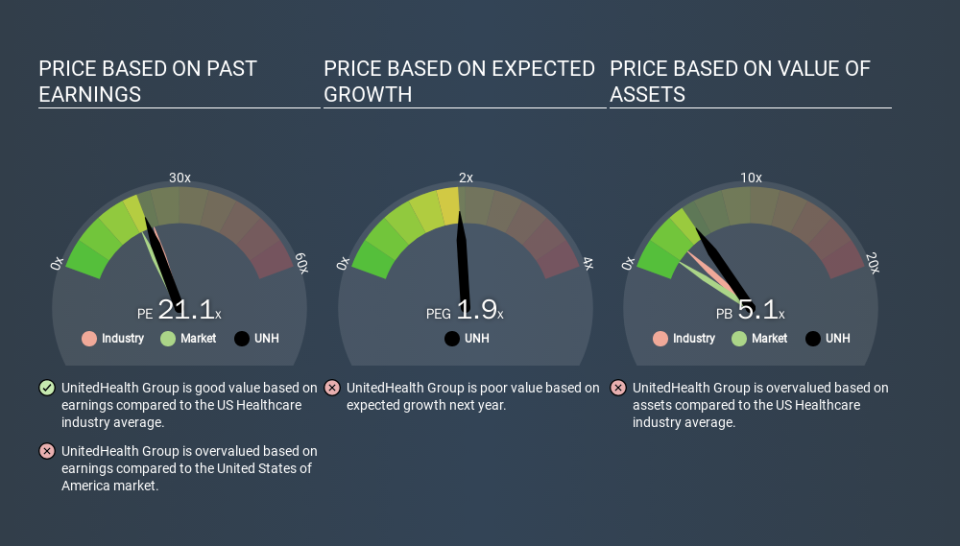Do You Like UnitedHealth Group Incorporated (NYSE:UNH) At This P/E Ratio?

Today, we'll introduce the concept of the P/E ratio for those who are learning about investing. We'll show how you can use UnitedHealth Group Incorporated's (NYSE:UNH) P/E ratio to inform your assessment of the investment opportunity. Based on the last twelve months, UnitedHealth Group's P/E ratio is 21.13. That means that at current prices, buyers pay $21.13 for every $1 in trailing yearly profits.
Check out our latest analysis for UnitedHealth Group
How Do You Calculate UnitedHealth Group's P/E Ratio?
The formula for price to earnings is:
Price to Earnings Ratio = Share Price ÷ Earnings per Share (EPS)
Or for UnitedHealth Group:
P/E of 21.13 = $295.13 ÷ $13.97 (Based on the trailing twelve months to September 2019.)
Is A High P/E Ratio Good?
A higher P/E ratio implies that investors pay a higher price for the earning power of the business. That is not a good or a bad thing per se, but a high P/E does imply buyers are optimistic about the future.
How Does UnitedHealth Group's P/E Ratio Compare To Its Peers?
The P/E ratio essentially measures market expectations of a company. You can see in the image below that the average P/E (22.5) for companies in the healthcare industry is roughly the same as UnitedHealth Group's P/E.
That indicates that the market expects UnitedHealth Group will perform roughly in line with other companies in its industry. So if UnitedHealth Group actually outperforms its peers going forward, that should be a positive for the share price. I would further inform my view by checking insider buying and selling., among other things.
How Growth Rates Impact P/E Ratios
Probably the most important factor in determining what P/E a company trades on is the earnings growth. When earnings grow, the 'E' increases, over time. And in that case, the P/E ratio itself will drop rather quickly. So while a stock may look expensive based on past earnings, it could be cheap based on future earnings.
UnitedHealth Group increased earnings per share by 7.3% last year. And its annual EPS growth rate over 5 years is 20%.
Remember: P/E Ratios Don't Consider The Balance Sheet
The 'Price' in P/E reflects the market capitalization of the company. That means it doesn't take debt or cash into account. In theory, a company can lower its future P/E ratio by using cash or debt to invest in growth.
While growth expenditure doesn't always pay off, the point is that it is a good option to have; but one that the P/E ratio ignores.
How Does UnitedHealth Group's Debt Impact Its P/E Ratio?
Net debt totals 10% of UnitedHealth Group's market cap. This could bring some additional risk, and reduce the number of investment options for management; worth remembering if you compare its P/E to businesses without debt.
The Bottom Line On UnitedHealth Group's P/E Ratio
UnitedHealth Group trades on a P/E ratio of 21.1, which is above its market average of 18.7. Given the debt is only modest, and earnings are already moving in the right direction, it's not surprising that the market expects continued improvement.
Investors have an opportunity when market expectations about a stock are wrong. People often underestimate remarkable growth -- so investors can make money when fast growth is not fully appreciated. So this free report on the analyst consensus forecasts could help you make a master move on this stock.
You might be able to find a better buy than UnitedHealth Group. If you want a selection of possible winners, check out this free list of interesting companies that trade on a P/E below 20 (but have proven they can grow earnings).
If you spot an error that warrants correction, please contact the editor at editorial-team@simplywallst.com. This article by Simply Wall St is general in nature. It does not constitute a recommendation to buy or sell any stock, and does not take account of your objectives, or your financial situation. Simply Wall St has no position in the stocks mentioned.
We aim to bring you long-term focused research analysis driven by fundamental data. Note that our analysis may not factor in the latest price-sensitive company announcements or qualitative material. Thank you for reading.

 Yahoo Finance
Yahoo Finance 
